Heat Waves Occurrence and Outdoor Workers’ Self-assessment of Heat Stress in Slovenia and Greece
Abstract
1. Introduction
2. Materials and Methods
2.1. Heat Wave Climatology
2.2. Workers’ Perception of Heat Stress
3. Results
3.1. Comparison of Heat Waves in Slovenia and Greece
3.2. Worker’s Self-Assessment of Heat Stress Impacts
4. Discussion
5. Conclusions
Author Contributions
Funding
Acknowledgments
Conflicts of Interest
References
- Lau, N.C.; Nath, M.J. A Model Study of Heat Waves over North America: Meteorological Aspects and Projections for the Twenty-First Century. J. Clim. 2012, 25, 4761–4784. [Google Scholar] [CrossRef]
- Meehl, G.A.; Tebaldi, C. More Intense, More Frequent, and Longer Lasting Heat Waves in the 21st Century. Science 2004, 305, 994–997. [Google Scholar] [CrossRef] [PubMed]
- Bittner, M.I.; Matthies, E.F.; Dalbokova, D.; Menne, B. Are European countries prepared for the next big heat-wave? Eur. J. Public Health 2013, 24, 615–619. [Google Scholar] [CrossRef] [PubMed]
- Russo, S.; Sillman, J.; Fischer, E.M. Top ten European heatwaves since 1950 and their occurrence in the coming decades. Environ. Res. Lett. 2015, 10, 124003. [Google Scholar] [CrossRef]
- Pereira, S.C.; Marta-Almeida, M.; Carvalhocand, A.C.; Rocha, A. Heat wave and cold spell changes in Iberia for a future climate scenario. Int. J. Climatol. 2017, 37, 5192–5205. [Google Scholar] [CrossRef]
- WMO; WHO. Heatwaves and Health: Guidance on Warning-System Development; McGregor, G.R., Bessemoulin, P., Ebi, K., Menne, B., Eds.; World Meteorological Organization (WMO): Geneva, Schwitzerland, 2015; p. 96. ISBN 978-92-63-11142-5. [Google Scholar]
- IPCC. Managing the Risks of Extreme Events and Disasters to Advance Climate Change Adaptation; Field, C.B., Barros, V., Stocker, T.F., Qin, D., Dokken, D.J., Ebi, K.L., Mastrandrea, M.D., Eds.; A Special Report of Working Groups I and II of the Intergovernmental Panel on Climate Change; Cambridge University Press: Cambridge, UK; New York, NY, USA, 2012; p. 582, ISBN 978-1-107-02506-6 Hardback, ISBN 978-1-107-60780-4 Paperback. [Google Scholar]
- Watts, N.; Amann, M.; Ayeb-Karlsson, S.; Belesova, K.; Bouley, T.; Boykoff, M.; Byass, P. Countdown on health and climate change: From 25 years of inaction to a global transformation for public health. Lancet 2017, 391, 581–630. [Google Scholar] [CrossRef]
- Bouchama, A.; Knochel, J.P. Heat stroke. N. Engl. J. Med. 2002, 346, 1978–1988. [Google Scholar] [CrossRef]
- Parsons, K. Human Thermal Environments. The Effects of Hot, Moderate and Cold Temperatures on Human Health, Comfort and Performance, 3rd ed.; CRC Press; Taylor & Francis Group: London, UK, 2012; ISBN-10 146659599X, ISBN-13 978-1466595996. [Google Scholar]
- Nybo, L.; Kjellstrom, T.; Flouris, A.D.; Kajfež Bogataj, L. Global heating: Attention is not enough; we need acute and appropriate actions. Temperature 2017, 4, 199–201. [Google Scholar] [CrossRef]
- Gao, C.; Kuklane, K.; Östergren, P.O.; Kjellstrom, T. Occupational heat stress assessment and protective strategies in the context of climate change. Int. J. Biometeorol. 2017, 62, 359–371. [Google Scholar] [CrossRef]
- Pascal, M.; Wagner, V.; Le Tertre, A.; Laaidi, K.; Honoré, C.; Bénichou, F.; Beaudeau, P. Definition of temperature thresholds: The example of the French heat wave warning system. Int. J. Biometeorol. 2013, 57, 21–29. [Google Scholar] [CrossRef]
- Lowe, D.; Ebi, K.L.; Forsberg, B. Heatwave Early Warning Systems and Adaptation Advice to Reduce Human Health Consequences of Heatwaves. Int. J. Environ. Res. Public Health 2011, 8, 4623–4648. [Google Scholar] [CrossRef] [PubMed]
- Flouris, A.D.; Dinas, P.C.; Ioannou, L.G.; Nybo, L.; Havenith, G.; Kenny, G.P.; Kjellstrom, T. Workers’ health and productivity under occupational heat strain: A systematic review and meta-analysis. Lancet Planet Health 2018, 2, 521–531. [Google Scholar] [CrossRef]
- Bethel, J.W.; Harger, R. Heat-Related Illness among Oregon Farmworkers. Int. J. Environ. Res. Public Health 2014, 11, 9273–9285. [Google Scholar] [CrossRef] [PubMed]
- Ioannou, L.G.; Tsoutsoubi, L.; Samoutis, G.; Kajfez Bogataj, L.; Kenny, G.P.; Nybo, L.; Kjellstrom, T.; Flouris, A.D. Time-motion analysis as a novel approach for evaluating the impact of environmental heat exposure on labor loss in agriculture workers. Temperature 2017, 4, 330–340. [Google Scholar] [CrossRef] [PubMed]
- Pogačar, T.; Črepinšek, Z.; Kajfež Bogataj, L.; Nybo, L. Comprehension of climatic and occupational heat stress amongst agricultural advisers and workers in Slovenia. Acta Agriculturae Slovenica 2017, 109, 545–554. [Google Scholar] [CrossRef]
- Yi, W.; Chan, A.P.C. Effects of Heat Stress on Construction Labor Productivity in Hong Kong: A Case Study of Rebar Workers. Int. J. Environ. Res. Public Health 2017, 14, 1055. [Google Scholar] [CrossRef] [PubMed]
- Pogačar, T.; Casanueva, A.; Kozjek, K.; Ciuha, U.; Mekjavić, I.B.; Kajfež Bogataj, L.; Črepinšek, Z. The effect of hot days on occupational heat stress in the manufacturing industry: Implications for workers’ well-being and productivity. Int. J. Biometeorol. 2018, 62, 1251–1264. [Google Scholar] [CrossRef] [PubMed]
- Hunt, B.G. A Climatology of Heat Waves from a Multimillennial Simulation. J. Clim. 2007, 20, 3802–3821. [Google Scholar] [CrossRef]
- ECA&D project. Available online: https://www.ecad.eu/ (accessed on 18 October 2017).
- SMD (Slovenian Meteorological Society). Available online: http://www.smd.v-izdelavi.si/data/upload/vrocinski_val(1).pdf (accessed on 11 October 2017).
- Kysely, J. Recent severe heat waves in central Europe: How to view them in a long-term prospect? Int. J. Climatol. 2010, 30, 89–109. [Google Scholar] [CrossRef]
- HEAT-SHIELD Project. Available online: https://www.heat-shield.eu/ (accessed on 23 January 2019).
- Kjellstrom, T.; Odland, J.O.; Nilsson, M. Progress in the Hothaps program assessing impacts and prevention of heat effects on working people in relation to local climate change. Asia Pacific Newslett. Occup. Heal Saf. 2011, 18, 24–25. [Google Scholar]
- De Boeck, H.J.; Dreesen, F.E.; Janssens, I.A.; Nijs, I. Climatic characteristics of heat waves and their simulation in plant experiments. Glob. Change Biol. 2010, 16, 1992–2000. [Google Scholar] [CrossRef]
- Kuglitsch, F.G.; Toreti, A.; Xoplaki, E.; Della-Marta, P.M.; Zerefos, C.S.; Türkeş, M.; Luterbacher, J. Heat wave changes in the eastern Mediterranean since 1960. Geophys. Res. Lett. 2010, 37, L04802. [Google Scholar] [CrossRef]
- Kjellstrom, T.; Freyberg, C.; Lemke, B.; Otto, M.; Briggs, D. Estimating population heat exposure and impacts on working people in conjunction with climate change. Int. J. Biometeorol. 2017, 62, 291–306. [Google Scholar] [CrossRef] [PubMed]
- Flouris, A.D.; McGinn, R.; Poirier, M.P.; Louie, J.C.; Ioannou, L.G.; Tsoutsoubi, L.; Sigal, R.J.; Boulay, P.; Hardcastle, S.G.; Kenny, G.P. Screening criteria for increased susceptibility to heat stress during work or leisure in hot environments in healthy individuals aged 31–70 years. Temperature 2017, 5, 86–99. [Google Scholar] [CrossRef] [PubMed]
- Luther, M.; Gardiner, F.W.; Hansen, C.; Caldicott, D. Hot of Not: Physiological versus Meteorological Heatwaves–Support for a Mean Temperature Threshold. Int. J. Environ. Res. Public Health 2016, 13, 753. [Google Scholar] [CrossRef]
- McInnes, J.A.; Akram, M.; MacFarlane, E.M.; Keegel, T.; Sim, M.R.; Smith, P. Association between high ambient temperature and acute work-related injury: A case-crossover analysis using workers’ compensation claims data. Scand. J. Work Environ. Health 2017, 43, 86–94. [Google Scholar] [CrossRef] [PubMed]
- Van Loenhout, J.A.F.; Guha-Sapir, D. How resilient is the general population to heatwaves? A knowledge survey from the ENHANCE project in Brussels and Amsterdam. BMC Res. Notes 2016, 9, 499. [Google Scholar] [CrossRef]
- Piil, J.F.; Lundbye-Jensen, J.; Christiansen, L.; Ioannou, L.; Tsoutsoubi, L.; Dallas, C.N.; Mantzios, K.; Flouris, A.D.; Nybo, L. High prevalence of hypohydration in occupations with heat stress—Perspectives for performance in combined cognitive and motor tasks. PLoS ONE 2018, 13, e0205321. [Google Scholar] [CrossRef]
- Eckardt, K.U.; Coresh, J.; Devuyst, O.; Johnson, R.J.; Köttgen, A.; Levey, A.S.; Levin, A. Evolving importance of kidney disease: From subspecialty to global health burden. Lancet 2013, 382, 158–169. [Google Scholar] [CrossRef]
- Waikar, S.S.; Curhan, G.C.; Wald, R.; McCarthy, E.P.; Chertow, G.M. Declining mortality in patients with acute renal failure, 1988 to 2002. J. Am. Soc. Nephrol. 2006, 17, 1143–1150. [Google Scholar] [CrossRef]
- Xue, J.L.; Daniels, F.; Star, R.A.; Kimmel, P.L.; Eggers, P.W.; Molitoris, B.A.; Himmelfarb, J.; Collins, A.J. Incidence and mortality of acute renal failure in Medicare beneficiaries, 1992 to 2001. J. Am. Soc. Nephrol. 2006, 17, 1135–1142. [Google Scholar] [CrossRef] [PubMed]
- Krishnamurthy, S.; Mondal, N.; Narayanan, P.; Biswal, N.; Srinivasan, S.; Soundravally, R. Incidence and etiology of acute kidney injury in southern India. Indian J. Pediatr. 2013, 80, 183–189. [Google Scholar] [CrossRef] [PubMed]
- Naicker, S.; Aboud, O.; Gharbi, M.B. Epidemiology of acute kidney injury in Africa. Semin. Nephrol. 2008, 28, 348–353. [Google Scholar] [CrossRef] [PubMed]
- Lameire, N.H.; Bagga, A.; Cruz, D.; De Maeseneer, J.; Endre, Z.; Kellum, J.A.; Liu, K.D.; Mehta, R.L.; Pannu, N.; Van Biesen, W.; et al. Acute kidney injury: An increasing global concern. Lancet 2013, 382, 170–179. [Google Scholar] [CrossRef]
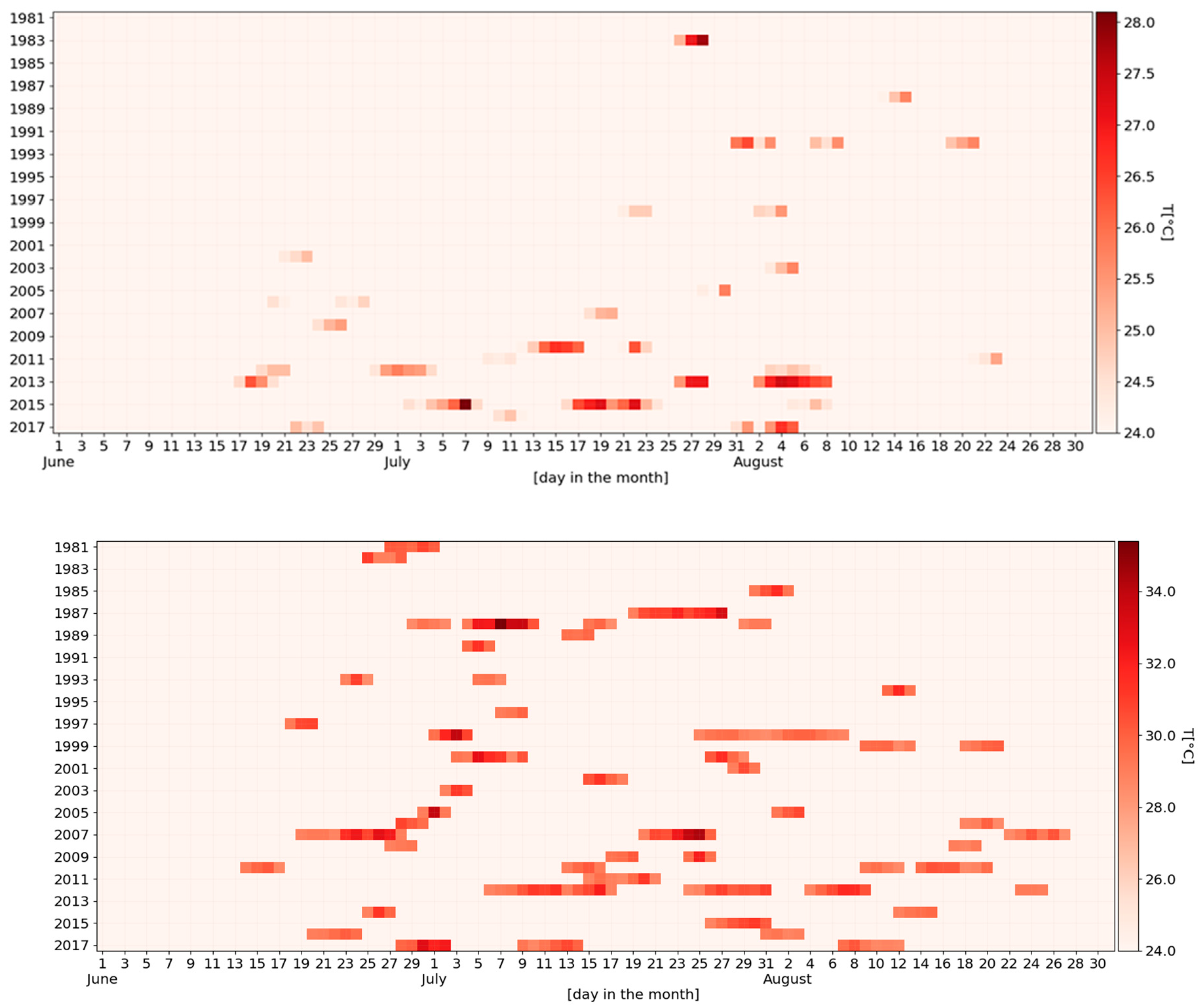

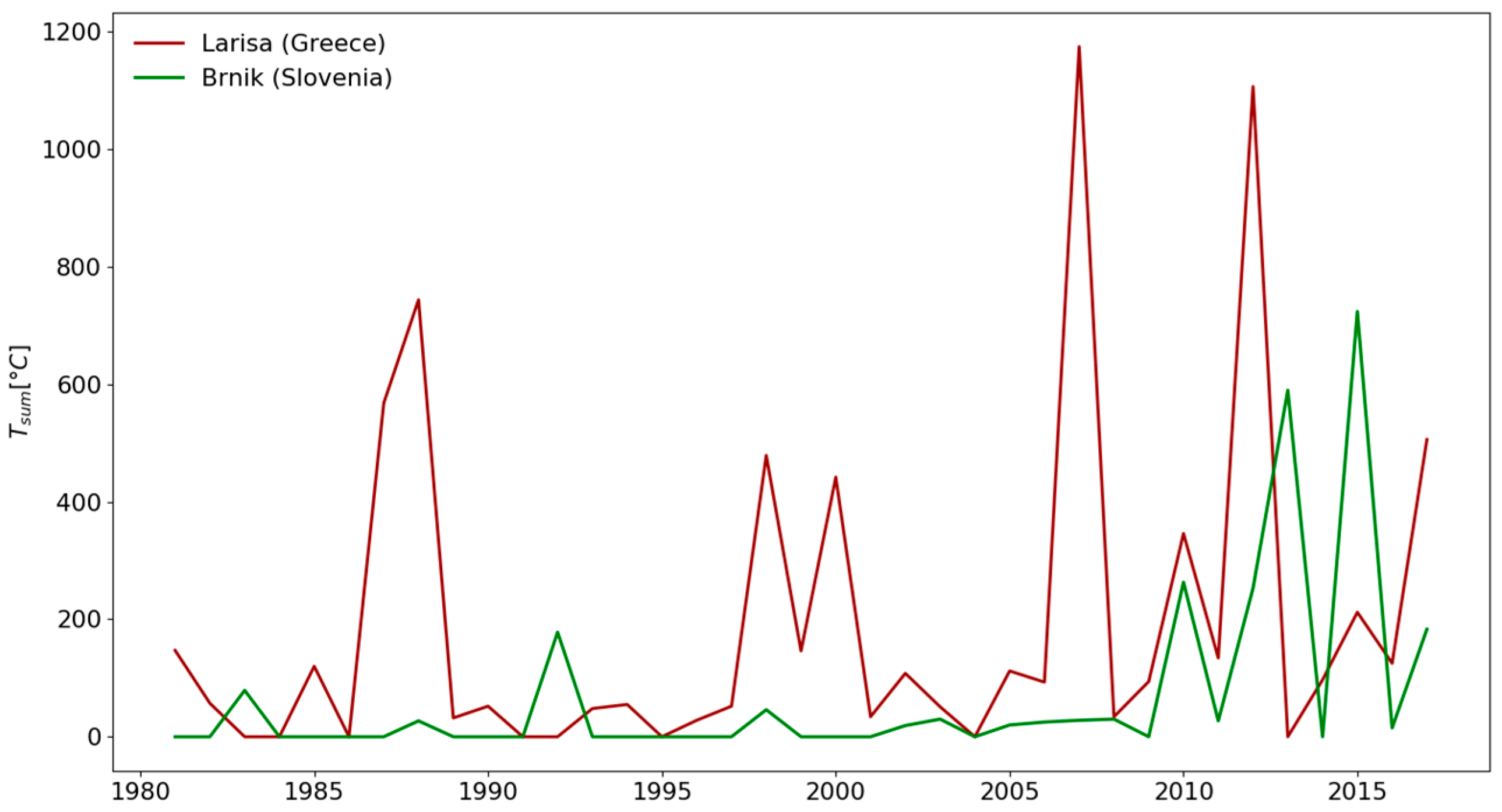
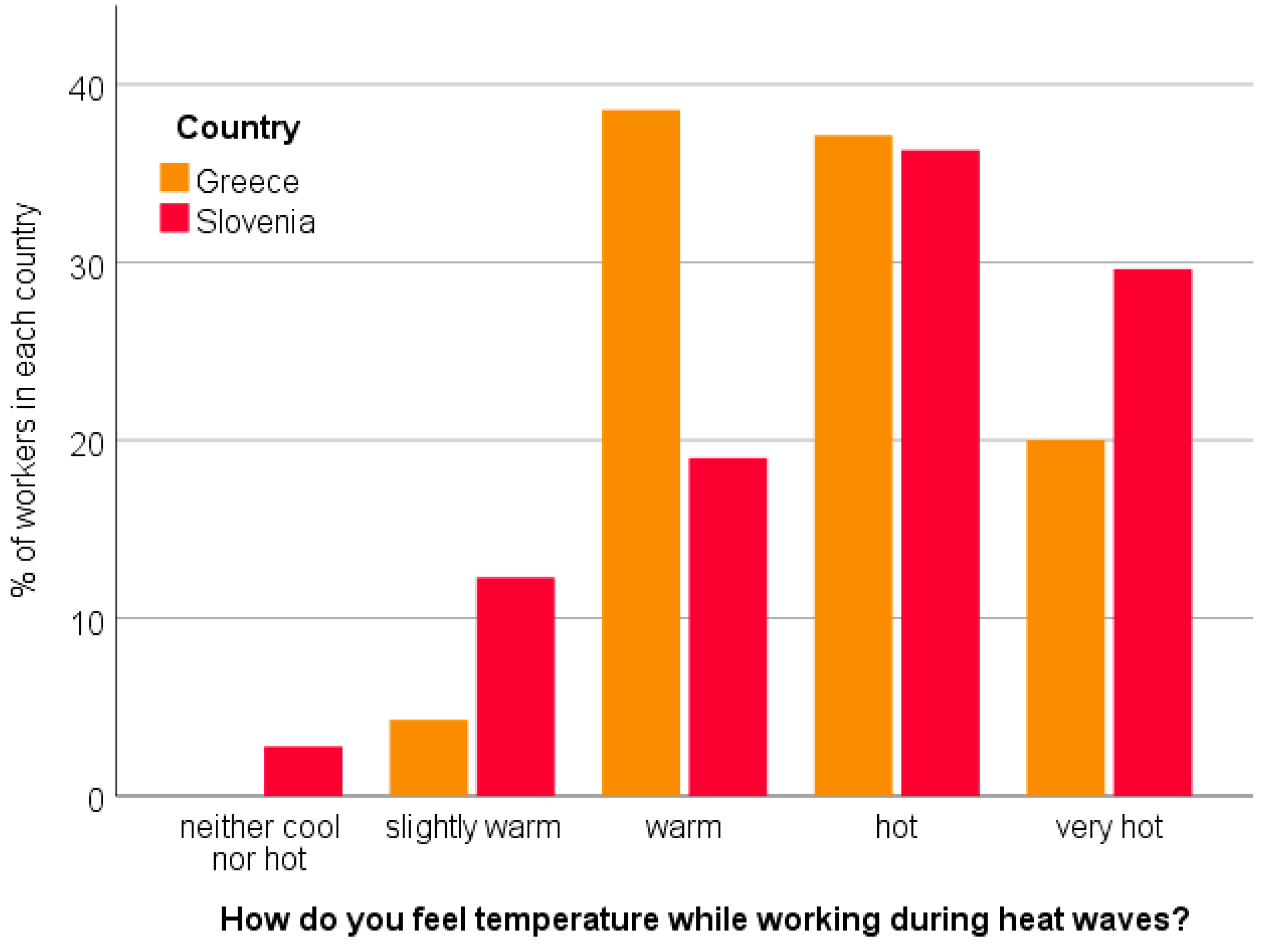
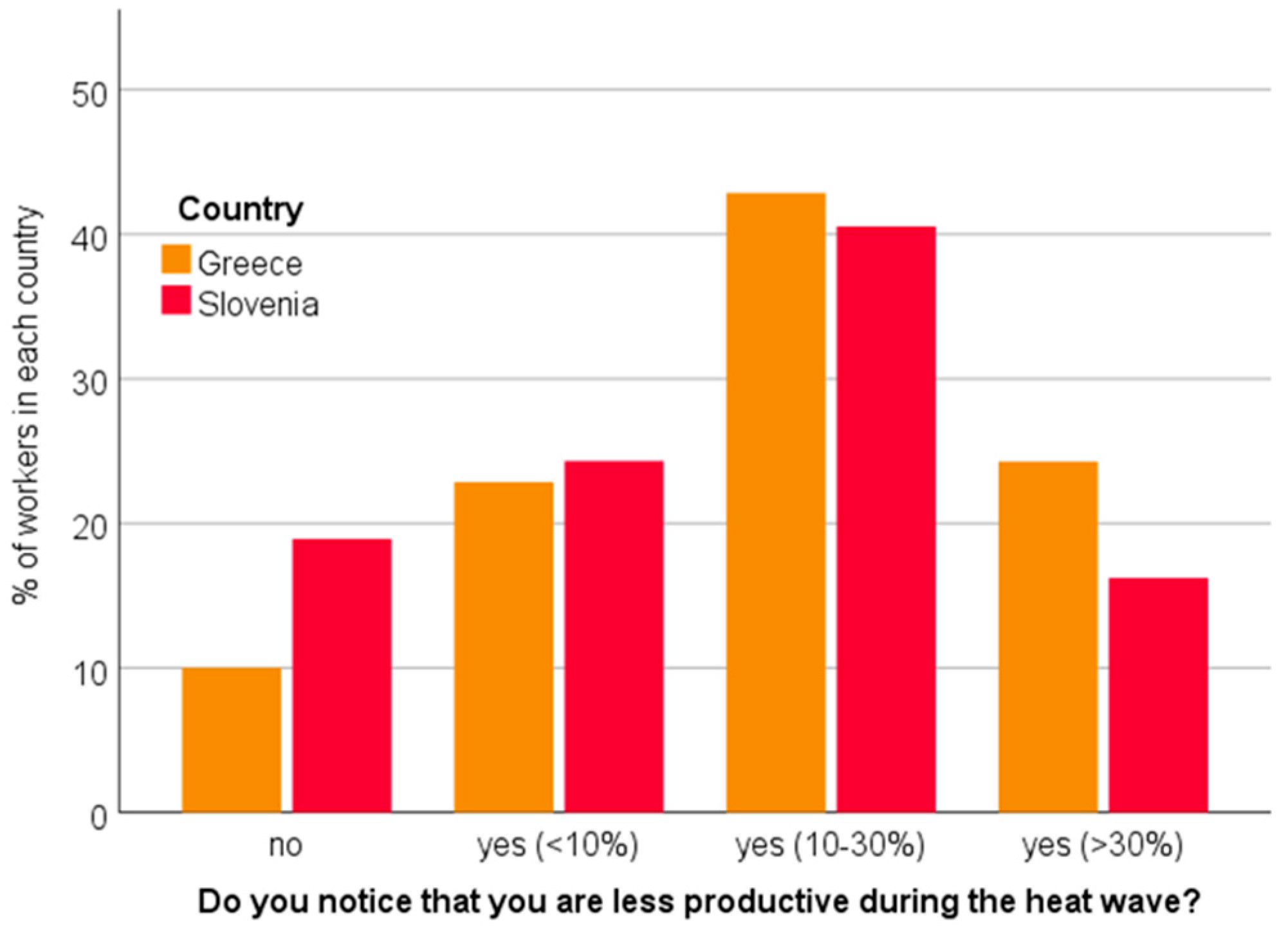
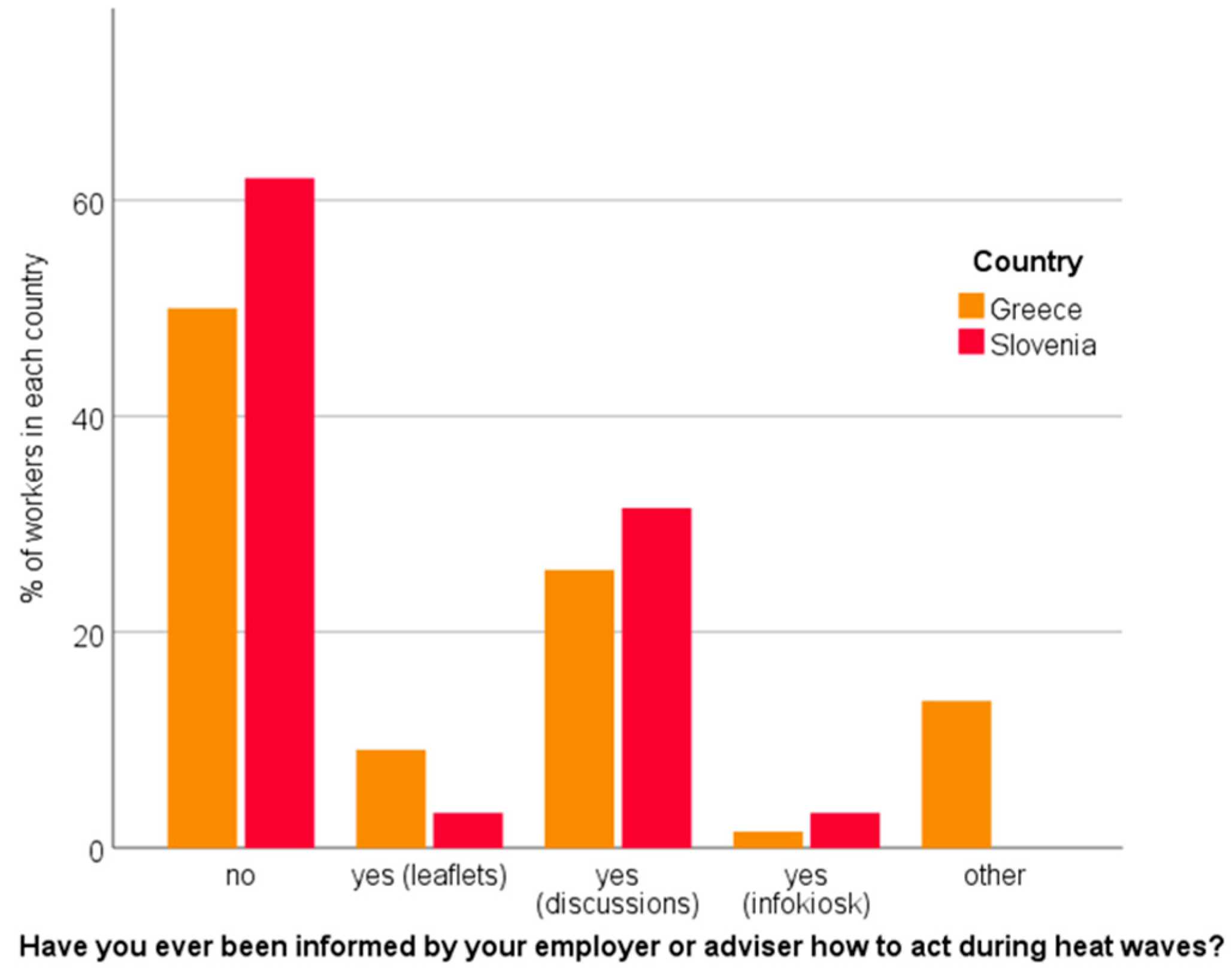
| Greece (n = 70) | Slovenia (n = 216) | |
|---|---|---|
| Gender | ||
| Male | 77.1% | 57.4% |
| Female | 22.9% | 42.6% |
| Age | ||
| 20–30 | 20.0% | 14.8% |
| 31–40 | 44.3% | 30.6% |
| 41–50 | 10.0% | 23.1% |
| 51–60 | 15.7% | 22.2% |
| 61 and more | 10.0% | 9.3% |
| Education level | ||
| Primary school or none | 20.0% | 5.6% |
| Secondary school | 21.4% | 43.5% |
| College | 25.7% | 26.4% |
| Bachelor’s degree | 24.3% | 21.3% |
| Master’s degree/PhD | 8.6% | 3.2% |
| Working outdoors | ||
| one–two thirds | 44.3% | 50.9% |
| two–three thirds | 55.7% | 49.1% |
| Chronic disease | ||
| Yes | 15.7% | 30.6% |
| No | 84.3% | 69.4% |
| Greece (n = 70) | Slovenia (n = 216) | p-Value | |
|---|---|---|---|
| Heat stress impact is negligible | |||
| Yes | 7.1% | 6.0% | 0.763 |
| No | 92.9% | 94.0% | |
| Heat stress has a significant impact on well-being | |||
| Yes | 60.0% | 74.1% | 0.025 * |
| No | 40.0% | 25.9% | |
| Heat stress has a significant impact on concentration | |||
| Yes | 25.7% | 38.0% | 0.062 |
| No | 74.3% | 62.0% | |
| Heat stress has a significant impact on productivity | |||
| Yes | 68.6% | 71.3% | 0.664 |
| No | 31.4% | 28.7% | |
| Experienced heat stress symptoms | |||
| None | 2.9% | 0.0% | 0.013 * |
| Thirst | 70.0% | 82.4% | 0.026 * |
| Tiredness | 51.4% | 62.0% | 0.116 |
| Dizziness | 18.6% | 24.1% | 0.340 |
| Confusion | 15.7% | 10.6% | 0.255 |
| Enhanced stress | 12.9% | 25.9% | 0.023 * |
| Excessive sweating | 67.1% | 84.7% | 0.010 * |
| Experienced heat induced diseases | |||
| Headache | 44.3% | 52.8% | 0.217 |
| Exhaustion | 51.4% | 62.0% | 0.116 |
| Prickly heat | 5.7% | 13.0% | 0.095 |
| Muscle cramps | 7.1% | 6.0% | 0.736 |
| Fainting | 4.3% | 8.3% | 0.259 |
| Nausea/vomiting | 5.7% | 13.9% | 0.066 |
| Heat cramps | 4.3% | 0.5% | 0.018 * |
| Heat stroke | 5.7% | 0.0% | <0.001 * |
| None | 22.9% | 15.3% | 0.144 |
| Hospitalization due to heat stress | |||
| No | 94.3% | 92.6% | 0.629 |
| Yes | 5.7% | 7.4% | |
| Can you reduce your exposure to heat stress | |||
| No | 24.3% | 12.5% | 0.018 * |
| Yes | 75.7% | 87.5% | |
| How can you reduce your exposure to heat stress | |||
| Increase the number of breaks during the work | 20.0% | 32.9% | 0.041 * |
| Retreat to cooler space during breaks | 41.4% | 54.2% | 0.064 |
| Wear appropriate clothes | 40.0% | 49.1% | 0.186 |
| Drink more water | 64.3% | 82.4% | 0.001 * |
| Adjust working schedule | 34.3% | 65.7% | <0.001 * |
© 2019 by the authors. Licensee MDPI, Basel, Switzerland. This article is an open access article distributed under the terms and conditions of the Creative Commons Attribution (CC BY) license (http://creativecommons.org/licenses/by/4.0/).
Share and Cite
Pogačar, T.; Žnidaršič, Z.; Kajfež Bogataj, L.; Flouris, A.D.; Poulianiti, K.; Črepinšek, Z. Heat Waves Occurrence and Outdoor Workers’ Self-assessment of Heat Stress in Slovenia and Greece. Int. J. Environ. Res. Public Health 2019, 16, 597. https://doi.org/10.3390/ijerph16040597
Pogačar T, Žnidaršič Z, Kajfež Bogataj L, Flouris AD, Poulianiti K, Črepinšek Z. Heat Waves Occurrence and Outdoor Workers’ Self-assessment of Heat Stress in Slovenia and Greece. International Journal of Environmental Research and Public Health. 2019; 16(4):597. https://doi.org/10.3390/ijerph16040597
Chicago/Turabian StylePogačar, Tjaša, Zala Žnidaršič, Lučka Kajfež Bogataj, Andreas D. Flouris, Konstantina Poulianiti, and Zalika Črepinšek. 2019. "Heat Waves Occurrence and Outdoor Workers’ Self-assessment of Heat Stress in Slovenia and Greece" International Journal of Environmental Research and Public Health 16, no. 4: 597. https://doi.org/10.3390/ijerph16040597
APA StylePogačar, T., Žnidaršič, Z., Kajfež Bogataj, L., Flouris, A. D., Poulianiti, K., & Črepinšek, Z. (2019). Heat Waves Occurrence and Outdoor Workers’ Self-assessment of Heat Stress in Slovenia and Greece. International Journal of Environmental Research and Public Health, 16(4), 597. https://doi.org/10.3390/ijerph16040597






